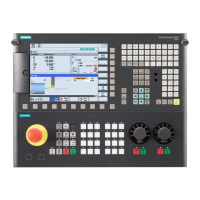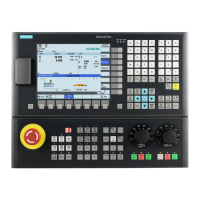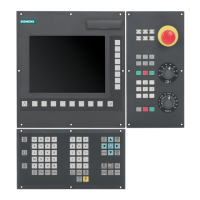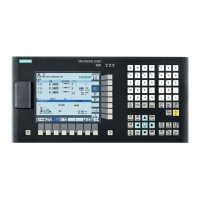K3: Compensations
4.6 Friction compensation (quadrant error compensation)
Extended Functions
Function Manual, 03/2013, 6FC5397-1BP40-3BA1
295
4.6.4.2 Function activation
Enable
The general enabling of the friction compensation is via:
MD32490 $MA_FRICT_COMP_MODE[ <axis> ] = 1
Activation
The activation of the friction compensation with adaptation characteristic is performed via:
● MD32500 FRICT_COMP_ENABLE[ <axis> ] = 1 (friction compensation ON)
● MD32510 $MA_FRICT_COMP_ADAPT_ENABLE[ <axis> ] = 1 (adaptation characteristic
OFF)
4.6.4.3 commissioning
To determine the characteristic parameters, the optimum compensation value Δn
opt
must be
determined at various operating points of the specified dynamic response range. See
Section "commissioning (Page 289)". A sufficiently large number of measured values for
large p
ath velocities and small circle radii is particularly important.
For the evaluation of the determined value pairs, it is recommended that these are displayed
graphically:
Δn
opt
= f(a), with Δn
opt
= optimum compensation value and a = acceleration at the quadrant
transitions.
The parameters of the adaptation characteristic determined from the measurement results
must then be entered in the machine data.
Characteristic parameters
Acceleration values
The acceleration which arises at the quadrant transitions of the axis changing direction is
calculated as follows:
a = v
2
/ r, with v = path velocity and r = circle radius
Note
The path velocity and therefore the axial acceleration a can be varied simply via the feedrate
override switch.
The acceleration values a
1
, a
2
and a
3
determined as characteristic parameters must be
entered in the following machine data. The following condition must be satisfied: a
1
< a
2
< a
3
● MD32550 $MA_FRICT_COMP_ACCEL1 (acceleration value 1)
● MD32560 $MA_FRICT_COMP_ACCEL2 (acceleration value 2)
● MD32570 $MA_FRICT_COMP_ACCEL3 (acceleration value 3)

